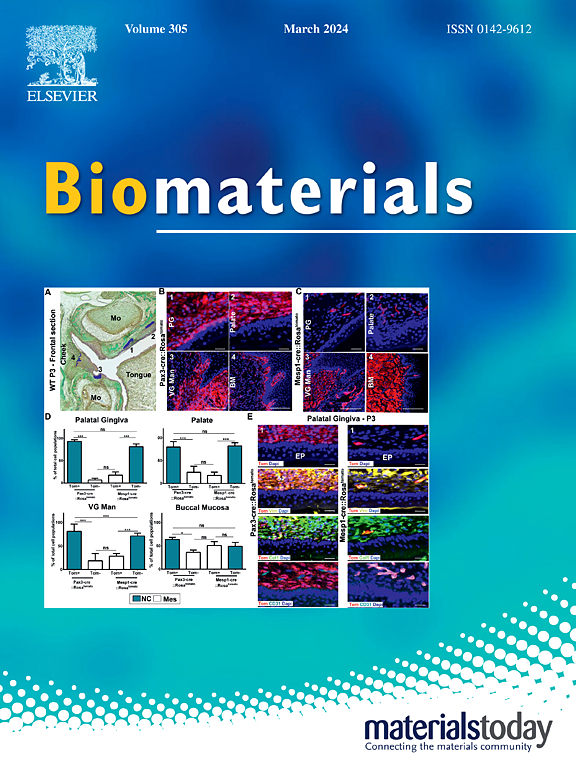Nanoparticles with reprogramming of mitochondrial respiratory chain complex and epigenetic modifications functions for osteoporosis treatment
IF 12.8
1区 医学
Q1 ENGINEERING, BIOMEDICAL
引用次数: 0
Abstract
Current therapies primarily focusing on osteoporosis often fail to address the root relationship between metabolic reprogramming and epigenetic modification alterations. Developing an efficient therapeutic approach with dual-pronged functionality for the treatment of osteoporosis represents a noteworthy challenge. Herein, samples from humans and rats with osteoporosis presented in this study underscore the correlation between mitochondrial metabolism, epigenetic modifications, and osteoporotic bone loss. Inspired by this, we focus on designing a nano-therapy that serves as a strategy, targeting both the maintenance of metabolic homeostasis and the modulation of epigenetic modifications, thereby achieving a dual-functional effect in the treatment of osteoporosis. Accordingly, 4-octyl itaconate (OI), which exhibits immunometabolic activity and regulates epigenetic modifications, was encapsulated within mesoporous silica (MSN) and further modified with a cerium ion-coordinated tannic acid (Ce-TA) supramolecular network on its surface for boosting antioxidant properties. In brief, MSN-OI@Ce-TA (MOCT NPs) exhibit synergistically enhanced antioxidant capabilities in pro-inflammatory macrophages and alleviates osteoporotic bone loss by restoring mitochondrial respiratory chain complex function, remodeling DNA and histone modifications, and thereby restoring osteoimmune homeostasis. Overall, these findings highlight the compelling dual treatment mechanisms of MOCT NPs, providing a theoretical basis for the management of osteoporosis.

具有线粒体呼吸链复合体重编程和表观遗传修饰功能的纳米颗粒用于骨质疏松症治疗
目前主要针对骨质疏松症的治疗往往不能解决代谢重编程和表观遗传修饰改变之间的根本关系。开发一种具有双管齐下功能的有效治疗方法来治疗骨质疏松症是一个值得注意的挑战。在本研究中,来自骨质疏松症的人类和大鼠的样本强调了线粒体代谢、表观遗传修饰和骨质疏松性骨质流失之间的相关性。受此启发,我们专注于设计一种纳米疗法,作为一种策略,同时针对代谢稳态的维持和表观遗传修饰的调节,从而在治疗骨质疏松症中实现双重功能效果。因此,将具有免疫代谢活性和调节表观遗传修饰的4-辛酯衣康酸酯(OI)包裹在介孔二氧化硅(MSN)中,并在其表面用铈离子配位单宁酸(Ce-TA)超分子网络进行修饰,以提高抗氧化性能。总之,MSN-OI@Ce-TA (MOCT NPs)在促炎巨噬细胞中表现出协同增强的抗氧化能力,并通过恢复线粒体呼吸链复合物功能、重塑DNA和组蛋白修饰,从而恢复骨免疫稳态,减轻骨质疏松性骨质流失。总之,这些发现突出了MOCT NPs的双重治疗机制,为骨质疏松症的治疗提供了理论基础。
本文章由计算机程序翻译,如有差异,请以英文原文为准。
求助全文
约1分钟内获得全文
求助全文
来源期刊

Biomaterials
工程技术-材料科学:生物材料
CiteScore
26.00
自引率
2.90%
发文量
565
审稿时长
46 days
期刊介绍:
Biomaterials is an international journal covering the science and clinical application of biomaterials. A biomaterial is now defined as a substance that has been engineered to take a form which, alone or as part of a complex system, is used to direct, by control of interactions with components of living systems, the course of any therapeutic or diagnostic procedure. It is the aim of the journal to provide a peer-reviewed forum for the publication of original papers and authoritative review and opinion papers dealing with the most important issues facing the use of biomaterials in clinical practice. The scope of the journal covers the wide range of physical, biological and chemical sciences that underpin the design of biomaterials and the clinical disciplines in which they are used. These sciences include polymer synthesis and characterization, drug and gene vector design, the biology of the host response, immunology and toxicology and self assembly at the nanoscale. Clinical applications include the therapies of medical technology and regenerative medicine in all clinical disciplines, and diagnostic systems that reply on innovative contrast and sensing agents. The journal is relevant to areas such as cancer diagnosis and therapy, implantable devices, drug delivery systems, gene vectors, bionanotechnology and tissue engineering.
 求助内容:
求助内容: 应助结果提醒方式:
应助结果提醒方式:


